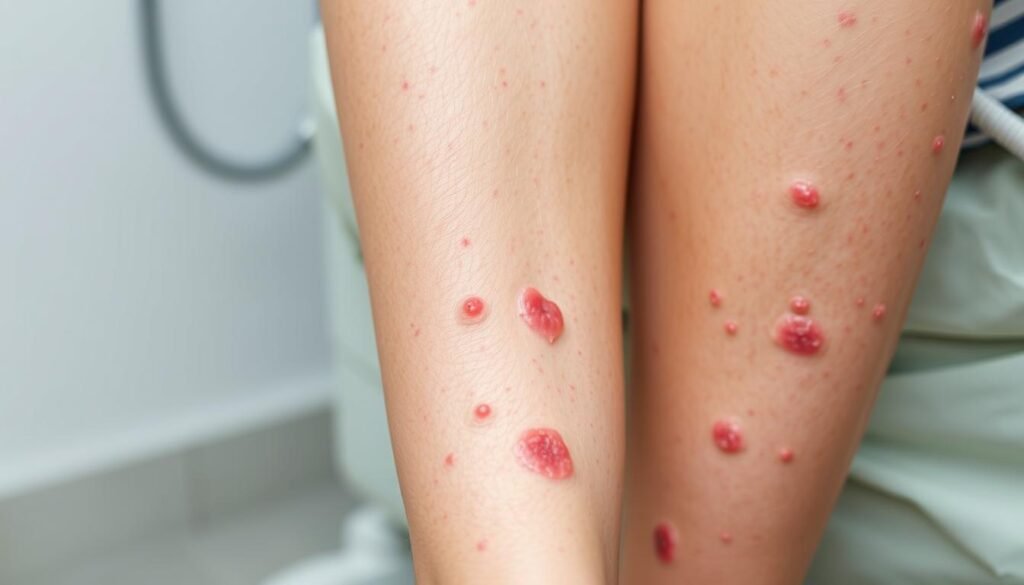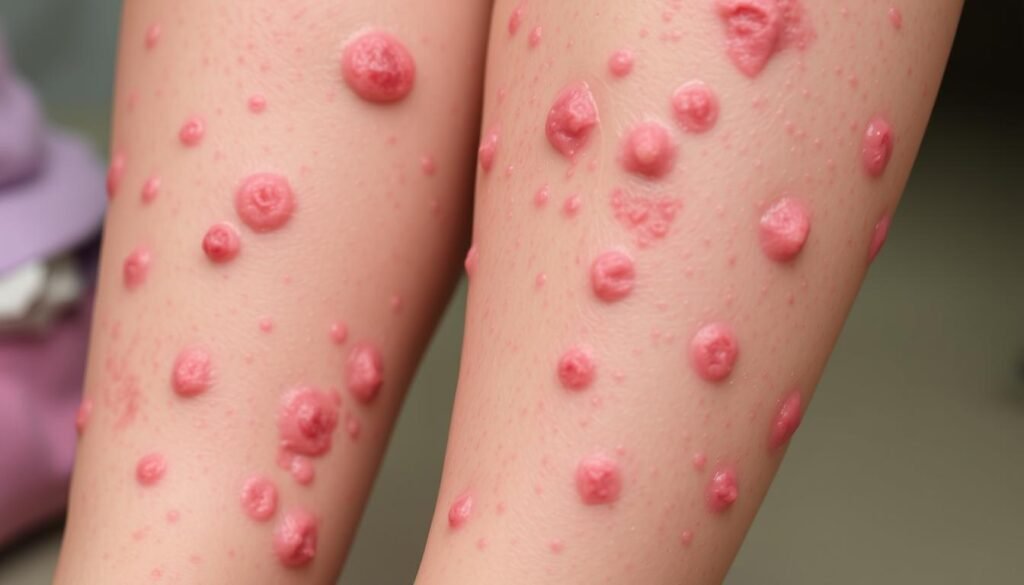Did you know that up to 70% of adults can get folliculitis during their lives? This skin issue, which affects hair follicles, often leads to small red bumps. It can also cause itching and pus-filled blisters on legs and other parts. Getting to know about folliculitis is key for recognizing and managing it early. This article gives a detailed look at folliculitis, with photos of what it looks like on the legs to help see and understand it.
Key Takeaways
- Folliculitis is a common skin condition that can affect anyone.
- It manifests as red bumps and pus-filled blisters, particularly on hair-bearing areas.
- Shaving, tight clothing, and excessive sweating are common triggers of leg folliculitis.
- Illustrative leg folliculitis images can greatly assist in identification.
- Understanding the symptoms can lead to quicker treatment and prevention methods.
Understanding Folliculitis
Folliculitis is a common skin issue where hair follicles become inflamed or infected. It can happen anywhere on your body where hair exists. This includes your legs, showing up as small bumps or pimples around the hair. Folliculitis definition shows it’s similar to acne, which can be confusing.
The main cause of bacterial folliculitis is Staphylococcus aureus. This bacterium lives on the skin of about 30% of people without causing issues. Problems arise when it enters hair follicles, especially through skin breaks. Hot tub folliculitis, caused by Pseudomonas aeruginosa, comes from contaminated water. Symptoms appear quickly, within 1 to 2 days after being in the water.
Bad shaving practices, especially in those with curly hair, can lead to pseudofolliculitis barbae. This shows how shaving can irritate hair follicles. Those with weakened immune systems may get a type called eosinophilic folliculitis, linked to immune problems.
Ignoring folliculitis might lead to scarring or hair loss. Sometimes, 10-20% of cases need antibiotics. Wearing tight clothes that trap sweat and heat is a risk factor. Staying hygienic and keeping places like hot tubs clean can lower your risk. This advice comes from health experts.
To learn more about folliculitis and related infections, you can get more information here.
Symptoms of Folliculitis on Legs
It’s important to spot folliculitis on legs early on. This skin issue mainly shows up as irritation near hair follicles, and it hurts. Looking for certain signs will help you know if it’s folliculitis.
Common Signs to Identify
Look out for these symptoms:
- Red bumps or pustules where hair grows.
- The skin may feel itchy, tender, or even painful.
- Healing pustules often get crusty tops.
- Groups of sore bumps that resemble acne.
Photos of leg folliculitis can visually explain these symptoms. They show the condition’s different stages. For deeper insights, check out this resource. It offers more info on spotting the symptoms.
What to Look For in Pictures
When looking at pictures of folliculitis on legs, notice these features:
- Bunches of red bumps, sometimes with pus.
- Inflamed skin patches around hair follicles.
- Blisters with liquid indicate irritation.
These signs help you better understand the symptoms. For more examples, view this link. It shows various folliculitis cases.
| Symptom | Description |
|---|---|
| Red Bumps | Small, inflamed spots near hair growth. |
| Pustules | Clusters of fluid-filled blisters. |
| Itching | Strong itchiness, mainly around the upset spots. |
| Tenderness | Skin feels sore to touch, especially near irritated areas. |
| Crusting | Healed bumps get crusty, showing old pustules. |
Causes of Folliculitis on Legs
Folliculitis on legs stems mainly from bacterial infections. It can flare up when hair follicles get damaged. Often, this damage happens due to shaving, using hot tubs, or wearing tight clothes. Other culprits include fungal infections, viruses, and parasites.
Bacterial Infections and Other Factors
Bacteria living on our skin usually cause bacterial folliculitis. Shaving can lead to ingrown hairs, making regrown hair curl back and irritate. Clothing that’s too tight, sports gear, and heavy lotions can block follicles, causing inflammation. Additionally, being in a warm, moist climate can make sweating contribute to the problem.
Several risk factors may make someone more prone to folliculitis. Having diabetes, eczema, or acne increases your chances. Those with weaker immune systems, including people with organ transplants, specific cancers, or HIV/AIDS, are at higher risk. To help avoid skin damage, it’s advised to use electric razors or new blades when shaving.
| Cause | Details | Risk Factors |
|---|---|---|
| Bacterial Infections | Commonly caused by bacteria on the skin’s surface. | Weakened immune systems. |
| Ingrown Hairs | Hair curling back into the skin from shaving. | Frequent shaving. |
| Friction | Caused by tight clothing and sports equipment. | Active lifestyles. |
| Fungal Infections | Less common but still a potential cause. | Hot, humid environments. |
| Excessive Sweating | Contributes to hair follicle inflammation. | Warm climates. |
Knowing about these causes and risks can help in preventing and managing the condition effectively before it becomes severe.
Folliculitis on Legs Pictures: What State to Expect
Knowing about different types of folliculitis on the legs is key. Looking at folliculitis on legs pictures shows what might happen. You might see mild red bumps or more severe pus-filled spots.
The leg folliculitis visuals provided show this range well. Mild cases look like red spots. Worse infections have swelling and more pus. These pictures are key for knowing how bad the condition is and when to seek help.

About 10% of patients treated for related problems get folliculitis. It can show up on the thighs and buttocks. The images of folliculitis on legs help in knowing when it’s urgent to act. The look of the infection signals when to get help.
| Stage of Folliculitis | Description | Visual Characteristics |
|---|---|---|
| Mild | Red bumps around hair follicles | Small, irritated follicles. |
| Moderate | Pus-filled bumps | Swelling and visible pus accumulation. |
| Severe | Warm, painful lesions | Larger lumps with possible drainage. |
Looking at the folliculitis on legs pictures helps people understand their condition better. They can then get the right treatment when needed.
Diagnosis of Folliculitis
Doctors start by closely looking at the skin that’s affected. They ask patients about their symptoms and past health issues. Often, knowing when to see a dermatologist is key if home treatments don’t help after a few days. It’s important to act quickly to prevent worse problems and get the right treatment.
When to See a Dermatologist
If your skin doesn’t get better with home care, seeing a dermatologist is needed. Reasons to make an appointment include:
- Persistent or worsening symptoms after home treatments
- Presence of larger boils or carbuncles
- Symptoms suggestive of a yeast or fungal infection
- Fever or systemic signs of infection
Tests Involved in Diagnosis
Doctors use several tests to find out what’s causing the infection. They may scrape the skin to check for yeast under a microscope. A swab test can identify the germ responsible. In some cases, a skin biopsy is done to rule out other conditions. Often, over-the-counter medicines aren’t enough, and doctors prescribe stronger drugs like antibiotics.
Treatment Options for Folliculitis on Legs
Treatment for folliculitis on legs depends on how serious it is. Most people can handle mild cases with home treatments and items from the store. When those don’t work, doctors’ treatments may be needed. Knowing your options is key to managing this skin problem well.
Home Care and Over-the-Counter Solutions
Simple home remedies can really help with folliculitis on legs. Warm compresses can calm red areas and help them heal. Using antibacterial soaps every day also helps. It cuts down on the bacteria that cause infections.
- Warm compresses to reduce inflammation
- Antibacterial soap for daily cleansing
- Topical creams containing benzoyl peroxide or salicylic acid
- Natural treatments like tea tree oil and apple cider vinegar
Many have found these steps work well, especially when they stay clean. For extra help, expert advice is offered at home remedies. It can make a big difference in skin health.
Prescription Treatments
For the worst infections or ongoing ones, doctors may give you medicine. Oral antibiotics, like minocycline or doxycycline, are common. They target Staphylococcus aureus, a bug often behind folliculitis.
| Treatment Type | Examples | Purpose |
|---|---|---|
| Topical Treatments | Antibiotic creams, retinoids | Direct application to reduce symptoms |
| Systemic Antibiotics | Minocycline, doxycycline | Address severe or recurrent infections |
| Corticosteroids | Topical creams | Manage inflammation and symptoms |
| Dermatological Therapies | Antiseptic shampoos | Reduce bacterial load and promote healing |
While many cases get better on their own, the right treatment can help a lot. It’s important to see a doctor for what will work best for you. For those with ongoing issues, understanding your skin and medical support is vital. More info can be found at prescription antibiotics.

Prevention Tips for Folliculitis
Stopping folliculitis starts with good skin care and cleanliness. Simple actions can make a big difference in avoiding this skin issue.
Daily Skincare Routines
Keeping a daily skin care routine is vital to avoid folliculitis. Let’s look at some key daily steps:
- Cleanse regularly: Use soft cleansers to keep skin clean from oils and germs.
- Moisturize: Moisturizing helps keep skin moist and less irritated.
- Exfoliate: Exfoliating often gets rid of dead skin and keeps follicles open.
- Be cautious while shaving: For less irritation, use sharp, clean razors and shaving cream.
Clothing Choices and Hygiene Practices
Picking the right clothes and staying clean are key to stop folliculitis. Follow these tips:
- Opt for breathable fabrics: Loose and natural fiber clothes, like cotton, lessen sweat and rubbing.
- Change out of wet clothes promptly: Switch to dry clothes after sweating to stop bacteria.
- Use clean towels: Dry off with clean towels after baths or workouts to keep clean.
- Avoid sharing personal items: Sharing razors, towels, or clothes can spread germs that cause folliculitis.
Complications Related to Folliculitis
Knowing the folliculitis complications that follow untreated or severe cases is crucial for skin health. Mild cases often heal without issues, but worse cases can cause serious problems. It’s important to understand the symptoms and long-term effects to seek treatment early and avoid more issues.
What to Watch For
People with folliculitis should watch for signs that the condition is getting worse. Look out for symptoms like:
- Spreading redness
- Increased pain or swelling
- Fever and chills
- Fast heartbeat
- Low blood pressure
It’s critical to monitor these symptoms because risks of untreated folliculitis include the infection spreading. If you see these signs, get medical help quickly to prevent more complications.
Long-term Effects
Chronic or untreated folliculitis can damage the skin long-term. Permanent issues could include:
| Potential Long-term Effects | Description |
|---|---|
| Scarring | Severe infections can leave permanent scars on the skin. |
| Recurrent Infections | Individuals may face frequent flare-ups if underlying infection is not addressed. |
| Hair Loss | Hair follicles can be damaged, leading to potential hair loss in affected areas. |
Knowing about these long-term damage risks shows why it’s vital to keep up with hygiene and treatment. Staying proactive helps reduce the impact of folliculitis and its risks.

Lifestyle Changes to Manage Folliculitis
Making good lifestyle changes can really help with folliculitis. This skin issue is both annoying and painful. But, by looking at what you eat and handling other health problems, you can better your skin. This means fewer bad skin days.
Diet and Nutrition Considerations
Eating right plays a big part in keeping your skin healthy. This might lower how often you get folliculitis. Eat foods full of vitamins A, C, and E, as they help skin heal and boost your immune system. Drinking plenty of water keeps your skin soft and stops it from drying out. It’s also key for people with diabetes to watch their sugar since they have a higher risk of getting folliculitis.
Managing Underlying Conditions
If you have folliculitis, you might also have other health issues making it worse. Seeing your doctor often can help find ways to keep infections down and stop bad flare-ups. Health problems like diabetes or eczema need extra care because they make you more likely to get folliculitis. Changing your lifestyle means know what makes your skin worse. Change how you take care of your skin every day and avoid wearing tight clothes that can bug your skin.
| Lifestyle Change | Benefit |
|---|---|
| Balanced Diet | Supports skin health and boosts immunity |
| Staying Hydrated | Maintains skin elasticity, prevents dryness |
| Regular Check-ups | Monitors underlying conditions |
| Good Hygiene | Reduces risk of infection and flare-ups |
| Stress Management | Minimizes triggers that can lead to flare-ups |
To wrap up, these important changes can make a big difference. They help you manage folliculitis and improve your skin health. For more home remedies and tips, look into Healthline’s guide on folliculitis home treatment.
Conclusion
Knowing about folliculitis, especially on the legs, is key for quick help and good care. This skin issue shows up in many ways, with the most common type being caused by Staphylococcus aureus. It’s crucial to know the signs, like itchy and pus-filled bumps, so you can get the right treatment fast.
To manage folliculitis well, you need to take good care of your skin and stay clean. While some cases get better on their own in a few days, others might need more care. This might happen if the problem keeps coming back or is really bad. Learning the important facts about folliculitis helps you be ready to deal with it.
In the end, keeping an eye on your skin, talking to doctors, and making smart choices can prevent worse problems. Understanding this skin issue deeply helps people take better care of their skin. It also helps them be ready for any new problems.
